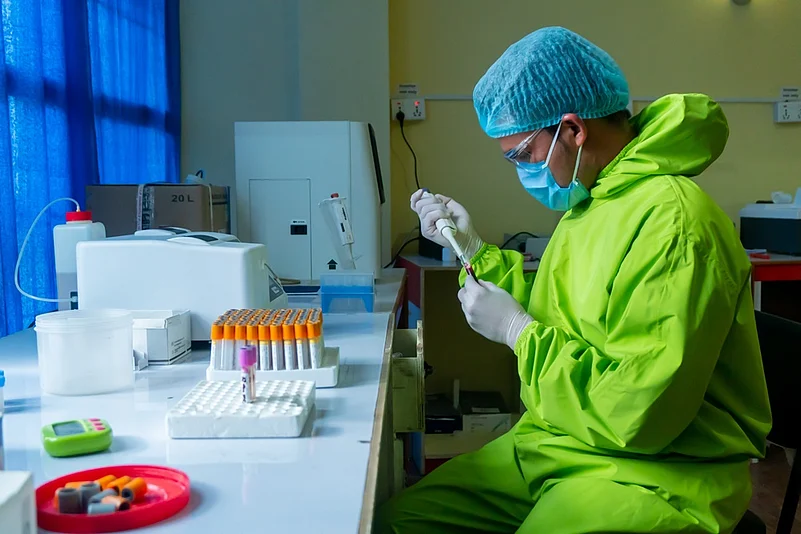As coronavirus cases surge around the world, with hospitals getting overstretched and economies gasping, we got two pieces of good news within a week from two US-based companies.
One, Pfizer (and its partner, the German company, BioNTech ) announced on November 9 that their mRNA based vaccine BNT162b2 against SARS-CoV-2 has more than 90 per cent effectiveness, and two, on November 16 Moderna claimed its mRNA based vaccine mRNA-1273 appears to be 94.5 per cent effective. Is that a dash of hope?
What does it mean?
The Food and Drug Administration (FDA) had set a bar of 50 per cent efficacy for the vaccine. These two appear far more protective than that with the claim of more than 90 per cent effectiveness.
Currently, more than 150 coronavirus vaccines are in development across the globe of which 11 have reached phase III trials. Moderna’s (mRNA-1273), Pfizer and BioNTech's (BNT162), Johnson & Johnson's (JNJ-78436735), India's Bharat Biotech and ICMR(Covaxin), United Kingdom's Novavax (NVX CoV2373), AstraZeneca-Oxford's (AZD1222), China's Sinopharm(not named) and CanSino (Ad5-nCoV) are promising.
To date, just two coronavirus vaccines have been approved ---- both by the Russian government. Sputnik V and EpiVacCorona ---- but experts have raised considerable concerns about the safety and efficacy of both.
But the fact that Pfizer and Moderna have got encouraging results is making experts optimistic about the entire field.
But is it safe?
Both Pfizer and Moderna have announced that no serious safety concerns have been observed in any of the participants during phase III trials (barring minor side effects fatigue, muscle aches, and pain at the injection site), Clinical trial/safety and additional efficacy data continue to be collected-participants will continue to be monitored for long-term protection and safety for an additional two years after their second dose, and the long term impact can only be firmly determined once millions of people get it.
AstraZeneca had to halt its phase III trial in September 2020 and twice later as some participants developed neurological symptoms. Recently, China's Sinovac had to stop its trial as one participant died.
The data is still preliminary and taken only after 7 days of the second dose ( both require people to get two shots, 3-4 weeks apart ). It could be years before it is known how long a coronavirus vaccine remains effective, which means like the flu vaccine, annual boosters could become a necessity.
“Infantry wins battles but logistics wins wars.” That statement is extemely relevant here, because -mRNA-based vaccines need to be stored at a very cold temperature. Both the Moderna and Pfizer vaccines are frozen, but at different temperatures.
Pfizer's vaccine needs to be stored at temperatures matching an Antarctic winter – a logistical nightmare. In India, with heatwaves exceeding 50º C, scarce ultra-cold freezers, poor electric supply, and a largely rural population, this will prove to be a major challenge.
We might be successful in the cities with Pfizer announcing that it will provide a "dry ice pack" container for its vaccines that can maintain a temperature of minus 70º C for up to 10 days and Moderna3 claiming a longer shelf-life of 30 days at refrigerated temperature, but this wil certainly not work in the rural Indian setup. The success of any Covid-19 vaccination programme will be critically dependent on the robustness of the cold chain.
WIll it work on children?
The answer is No. Both trials have been done only on adults.
When will this vaccination start?
Both will likely apply for emergency use authorization in the coming weeks after collecting more safety data, and then it may take weeks to know about the vaccine's safety, effectiveness, and the companies' ability to safely manufacture it at scale. The vaccine could be authorized for certain high-risk populations by early next year, but that would only happen if everything goes as planned and there are no unforeseen delays.
Does this mean we have won the battle against coronavirus?
The impact of Covid-19 vaccines on the pandemic will depend on several factors such as the effectiveness of the vaccines; how quickly they are approved, manufactured, and delivered; and how many people get vaccinated. It’s going to require many vaccines to meet the global demand for use across a range of populations and settings.
"A vaccine will complement the other tools we have, not replace them," WHO director-general Tedros Adhanom Ghebreyesus said. "A vaccine on its own will not end the pandemic."
Development of new technologies, even during a global crisis, does not automatically mean access---developing countries like India may have to wait a little longer.
Supplies of the vaccine would initially be prioritized with health workers, older people and other at-risk populations-it could take several years to reach the last person. The vaccines therefore will not start saving the world for at least several months, during which the virus will take many more lives unless the government takes more stringent public health measures.
Contact tracing, testing more and more people, isolation and quarantine will need to continue. We must continue to follow social distancing norms, mask-wearing, and hand hygiene practices.
(The author has been a lecturer, Department of Pediatrics, BRD Medical College, Gorakhpur, UP)
















